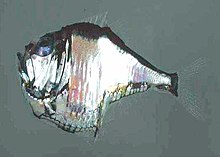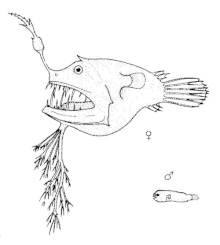Deep sea fish
Deep sea fish are fish that are adapted to life in sea depths below approx. 500 meters.
The deep sea is characterized by a water temperature of just under 4 ° C, the absence of vegetation and almost complete darkness. In the course of evolution , deep-sea fish have developed adaptations to this extreme environment. It is noteworthy that the special characteristics of deep-sea fish often arose independently of one another in genera that are not closely related in a very similar way ( convergence ).
The greatest depth at which a fish has ever been observed is 8,178 m (as of August 2017). At this depth was in Marianengraben a single fish from the family of Snailfish observed (Liparidae). The observed specimen comes very close to the maximum survival depth of 8200 m that can be achieved for fish (see below ).
Conditions in the deep sea and adaptations of the fish living there
Darkness

The daylight only reaches up to 300 m below the water surface. Fish that live in areas with low light often have large eyes in order to optimize the light output, for example deep-sea hatchet fish . However, some fish also live in complete darkness; the eyes then no longer have any function and regressed in the course of evolution. Many deep-sea fish also have luminous organs : In them, light is generated through a chemical reaction ( bioluminescence ), often with the help of symbiotic bacteria . Luminous organs perform different tasks in different species, such as illuminating the environment, looking for partners or attracting prey. The latter function is brought to perfection in deep-sea frogfish : These have an extension with a light organ at the end, the so-called fishing rod, which ends directly in front of the head. Small fish, attracted by the light, swim right in front of the frogfish's mouth and are eaten.
Reproduction
Due to the low population density, the likelihood that males and females of the same species will meet each other is extremely low. In some species, such as deep-sea angler fish , this led to the fact that the dwarf male grows firmly together with the female, is nourished by the female's bloodstream and henceforth is limited to the production of sperm.
Stabilization of proteins against high hydrostatic pressure
Trimethylamine- N -oxide (TMAO) stabilizes proteins in cells of fish against the increasing hydrostatic pressure with depth . The average concentration of TMAO in real bony fish increases from 40 mmol / kg at a depth of 0 m to 261 mmol / kg at a depth of 4850 m. This increases the internal osmolality in the fish cells with increasing habitat depth . The highest TMAO concentration to date was measured with 386 mmol / kg in the bell-bellied fish Notoliparis kermadecensis at a depth of 7000 m in the Kermadec Trench, which corresponds to an osmolality of 991 mOsmol / kg. This means that these fish cannot live below a depth of around 8,200 m: Higher TMAO concentrations would destabilize the proteins in the cell, such as myosin, which is responsible for muscle movements, to such an extent that they can no longer perform their function. Furthermore, the osmolality of seawater there reaches 1100 mOsmol / kg and at higher TMAO concentrations in the cells, seawater would flow into the tissue.
Deep-sea fish taxa

- Barracudinas (Paralepididae)
- Thornback eels (Notacanthiformes)
- Fang fish (also: Blattschupper; Anoplogastridae)
- Deep sea tadpoles (Ateleopodidae)
- Ghostfish (Opisthoproctidae)
- Lance fish (Alepisauridae)
- Lanternfish relatives
-
Maulstachler (Stomiiformes)
- Luminous fish (Phosichthyidae)
- Barten-Drachenfische (also: Schuppendrachenfische; Stomiidae)
- Deep-sea hatchetfish (Sternoptychidae)
- Pelican eels (Saccopharyngiformes)
- Beltfish (Regalecidae)
- Saber toothfish (Evermannellidae)
- Black Schlinger (Chiasmodontidae)
- Black heads (Alepocephalidae)
- Deep sea frogfish (Ogcocephalioidei)
- Deep sea flatheads (Bembridae)
- Whale-head-like (Cetomimiformes)
Web links
- Peter Tyson: Deep-Sea Bestiary. (English)
- Homepage of the deep-sea exhibition in the Senckenberg Nature Museum
Individual evidence
- ↑ Weird sea ghost breaks record for deepest living fish. NewScientist, December 19, 2014, accessed December 19, 2014 .
- ↑ Jonathan Amos: Fishy molecule sets depth limit. BBC , March 4, 2014, accessed March 5, 2014 .
- ↑ PH Yancey, ME Gerringer, JC Drazen, AA Rowden, A. Jamieson: Marine fish may be biochemically constrained from inhabiting the deepest ocean depths . In: Proceedings of the National Academy of Sciences . tape 111 , no. 12 , March 25, 2014, p. 4461-4465 , doi : 10.1073 / pnas.1322003111 .


